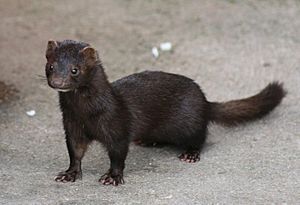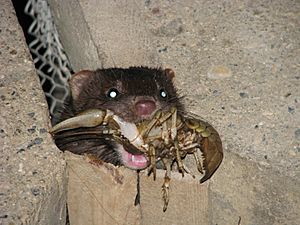Mink facts for kids
Quick facts for kids Mink |
|
|---|---|
 |
|
| American mink (Neovison vison) |
|
| Scientific classification | |
| Kingdom: | |
| Phylum: | |
| Class: | |
| Order: | |
| Family: | |
| Subfamily: | |
| Genus: |
Neovison and Mustela
|
| Species | |
Minks are dark-colored, semiaquatic (meaning they live partly in water), carnivorous mammals. They belong to the same family as weasels, otters, and ferrets, called Mustelidae.
There are two types of minks alive today: the American mink and the European mink. There was also a much larger sea mink, but it is now extinct.
The American mink is generally bigger and can adapt to more places than the European mink. It's hard to tell them apart just by looking, unless you see their skeleton. However, all European minks have a big white patch on their upper lip. Only some American minks have this patch. So, if a mink doesn't have the patch, it's definitely an American mink!
Scientists used to group both American and European minks in the same animal group (genus) called Mustela. But now, the American mink has its own group called Neovison.
The fur of the American mink has been very popular for making clothing. Because of this, people used to hunt them a lot. Now, most mink fur comes from farms. Some people who care about animal rights believe that minks on these farms should be treated better.
American minks have also spread to places like Europe and South America. This happened after they escaped from fur farms or were released by animal rights activists. In the UK, it's against the law to release minks into the wild. In some countries, any live mink caught in traps must be humanely killed.
Some scientists think that American minks have caused problems for the European mink. They believe the American mink is stronger and competes better for food and space. This might be why European mink numbers are going down. Trapping is sometimes used to control the number of American minks in places where they are not native.
Mink oil is used in some medical products and cosmetics. It's also used to treat and protect leather, making it waterproof.
Contents
Mink Species
- European mink Mustela lutreola
- American mink Neovison vison
- Sea mink Neovison macrodon (this species is extinct)
Mink Size
Male minks usually weigh about 1 kilogram (2.2 pounds) and are about 62 centimeters (24 inches) long. Minks raised on farms can be much bigger, sometimes weighing up to 3.2 kilograms (7 pounds).
Female minks are smaller. They weigh about 600 grams (1.3 pounds) and are about 51 centimeters (20 inches) long. These sizes do not include their tail, which can be from 12.8 cm (5 inches) to 22.8 cm (9 inches) long.
Mink Color
In the wild, a mink's coat is a rich, shiny brown and feels very silky. Minks raised on farms can have many different colors, from white to almost black. Wild minks in Britain can also show these color variations. Their fur has a thick, soft undercoat and dark, glossy, stiff guard hairs on top.
Reproduction and Life Cycle
Minks usually breed between April and May. After mating, it takes about 45 to 52 days for the baby minks to be born. A group of baby minks is called a litter, and there are usually 6 to 10 cubs (also called kittens) in a litter.
Mink Lifespan
Minks can live for up to ten years. However, in the wild, they usually don't live longer than three years.
Mink Diet

Wild minks eat fish and other animals that live in water, like crayfish. They also hunt small mammals, birds, and eggs. Adult minks might even eat young minks.
Minks raised on farms eat different foods. They often get old cheese, eggs, fish, and leftover meat from poultry farms. They also eat dog food and special commercial foods made for them. A large mink farm with 3,000 minks can use up to two tons of food every day!
Mink Predators
Many animals hunt minks. These include great horned owls, bobcats, foxes, coyotes, and wolves. Humans also hunt minks, sometimes to protect fish populations in lakes and rivers. However, because of hunting, minks are becoming endangered in some areas. Most mink fur sold today comes from fur farms, not from wild minks.
Where Minks Live
Minks love to live near water. You will rarely find them far from riverbanks, lakes, or marshes. Even when they travel, they tend to follow streams and ditches. Sometimes, they will leave the water for a short distance, especially when they are looking for rabbits, which are one of their favorite foods.
In some places, like Scotland and Iceland, minks have become a problem because they live along the seashore. They can even live in towns if there is enough water nearby. Minks can be active at any time, even when people are close by.
Mink Territories
Minks are very territorial animals. This means they claim an area as their own and defend it. A male mink will not let another male mink into his territory. However, male minks are usually less aggressive towards females.
Generally, the territories of male and female minks are separate. But sometimes, a female's territory might overlap with a male's, or even be completely inside a male's territory.
Mink territories are usually long and narrow. They stretch along river banks or around the edges of lakes or marshes. The size of a territory can vary, but it can be several miles long. Female minks have smaller territories than males.
Each territory has one or two main areas, called "core areas," where the mink spends most of its time. A core area usually has a good food supply, like a pond full of fish or a place with many rabbits. A mink might stay in its core area for several days. But it also travels to the far ends of its territory. These trips seem to be for defending its territory. The mink probably checks for signs of other minks and leaves its droppings, which have a strong scent, to show that the territory belongs to it.
Mink Farming and Viruses
Minks are one of the animals that can get the coronavirus. Scientists found that the virus could pass from minks to humans in the Netherlands. This discovery led the government there to stop mink farming earlier than planned. In the United States, cases of minks with COVID-19 were also found in Utah in 2020.
Images for kids
See also
 In Spanish: Visón para niños
In Spanish: Visón para niños




